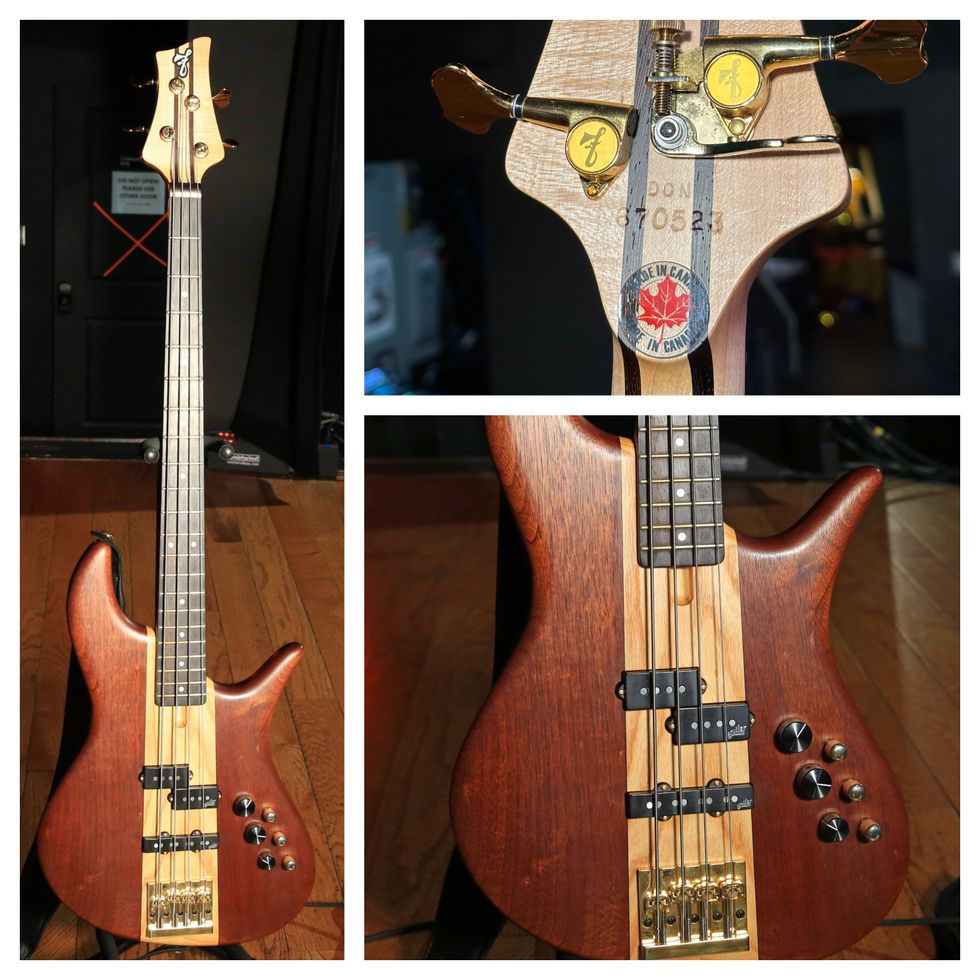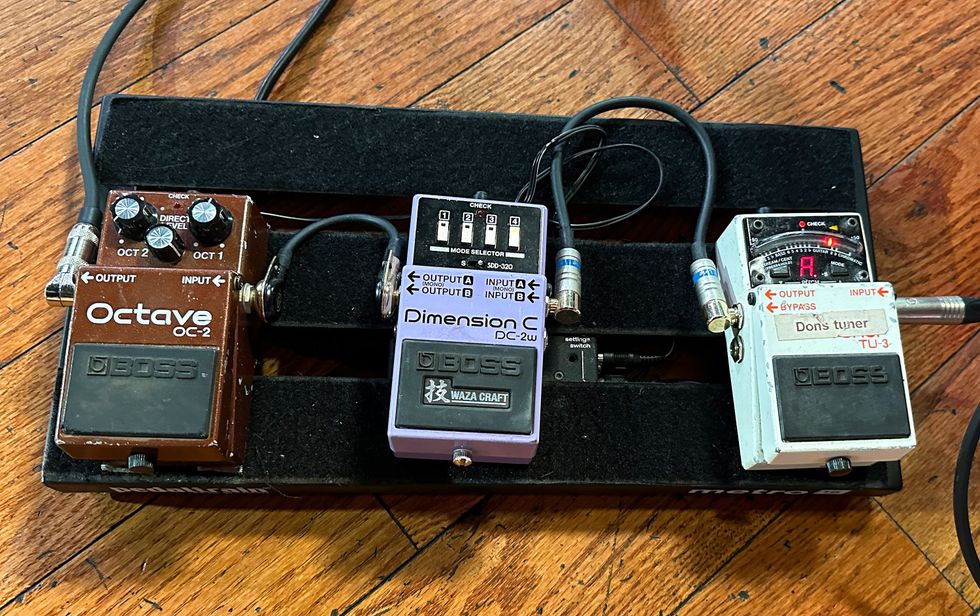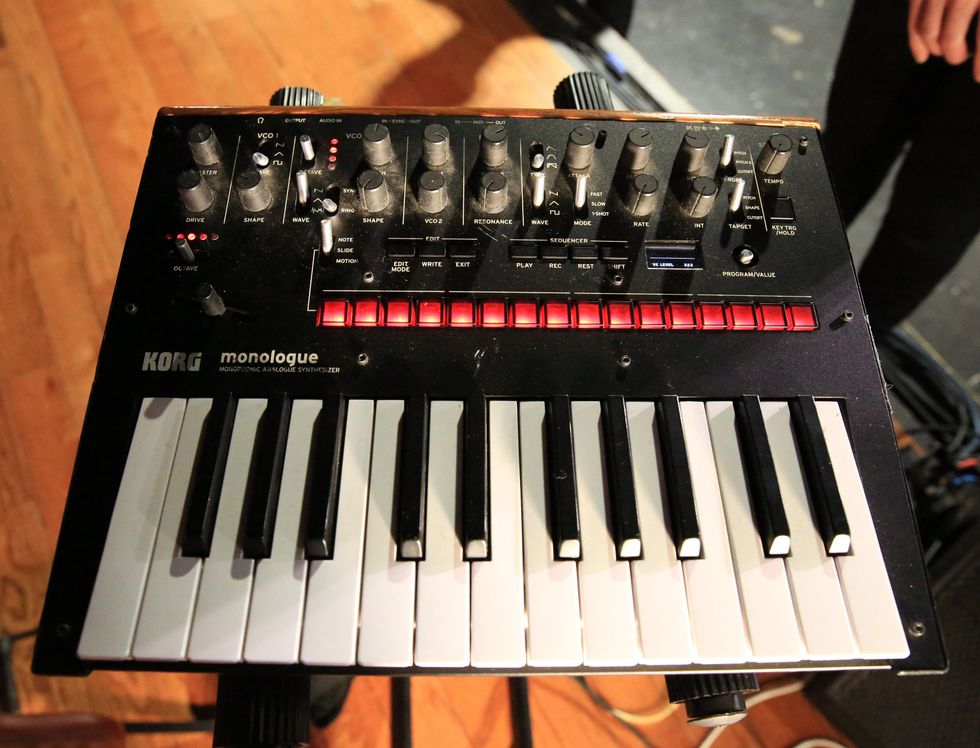The Italian-Australian may travel light—a single F Bass VF4—but he still delivers unlimited funky-fresh low-end thunder from Down Under that gets the women swooning, the men fuming, and everyone grooving like it’s Studio 54.
There’s comical bands (Gwar), there’s parody bands (Steel Panther), and there’s clever combinations of both (Mac Sabbath). The Italian-Australian Donny Benét is none of those and all of those at the same time. His polished compositions, breezy rhythms, and funky fretwork are no laughing matter. Instead, Donny is the joke … or is he?
“I thought, “What would I think if I saw some bald, chubby dude shredding on bass and fretless?’ I’d be like ‘hell yeah,’ so I might as well be the guy that’ll do it,” explains Benét.
Donny (born Ben Waples) is from a musical family in Sydney, Australia. He grew up performing on several instruments, became classically trained on piano, and earned a master’s degree in double bass. The fluent musician started a career as a jazz bassist for various artists in Sydney, and eventually shifted to an experimental jazz/electronica band, Triosk. While both endeavors were challenging and rewarding, Ben wasn’t having fun. After Triosk disbanded, Waples continued writing and recording on his own. It started with Cubase and a Line 6 DL4 that gave him 48-second loops. He started making “Donny Benét” joke songs. His friends and family continued encouraging him to make more, and before he knew it he had enough material to create Don’t Hold Back. (To this day he still records all the parts except saxophone, played by his brother Daniel Waples.) And through his passion for creating music combined with his love for ’70s funk and R&B—he mentions his introduction to electric bass was via a VHS tape featuring Larry Graham, Bernard Edwards, and Nile Rodgers—infused with the aesthetic and aura of Itala-disco performers, Donny Benét was born.
“I’m a seriously trained jazz musician in a prior life, and I try not to take myself too seriously now, but I’m deadly serious about taking the piss out of myself. I like humor, but I definitely don’t make joke music,” states Benét.
Since 2011, he’s released six albums, all showing an evolution and refinement of the Don. Each release has revealed a new part of Benét's infinite swagger, blending influences of Prince, Alan Vega, Lou Reed, Tom Jones, and, of course, James Jamerson, “Duck” Dunn, and the funk forefathers. Yes, Donny B can sweep you off your feet, but that’s because one thing reigns supreme—the music.
“With Donny I’ve always taken the approach of ‘what would I listen to?’ I started there and I continue to follow it. If no one likes it, that’s fine, so long as I like it. If someone else likes it, even better,” says Benét.
Before his headlining gig at Nashville’s Basement East, Donny B welcomed PG’s Chris Kies onstage to chat about his minimal-but-musical setup. Benét explains the origins of “Donny,” covers his custom Furlanetto 4-string and why he calls it “probably the best live instrument I got,” and discusses scoring tons of gear when the exchange rate presents deals.
Brought to you by D’Addario Pedalboard Essentials: & D’Addario"It's Probably the Best Live Instrument I Got."

Benét has been a longtime fan of Steve Swallow. He recalled seeing the bass legend perform with an “F” bass and assumed it was Fodera. He later learned it stood for F Bass, founded by George Furlanetto in 1978. During a tour that was taking him from Toronto to Chicago, Donny B swung by F Bass HQ in Hamilton, Ontario, to check out their instruments. He left the shop without a new companion, but later connected with current owner Marcel Furlanetto and spec’d out this beauty that he stylized after “an ’80s high-end custom bass.” So, he had to have the two-tone body decked out with gold hardware (with a Hipshot D Tuner), a 5-piece neck with stringers, an ebony fretboard, Aguilar AG 4 P/J-HC set pickups, and a custom F Bass 9V preamp with bass, mid, and treble boost. Though the custom F has a P-J setup, Benét notes that during the U.S. tour he’s been playing it more as a P, and because of its versatile setup he can approximate many of the basses in his collection, depending on pickup selection and EQ. He claims that every note is even and it’s a FOH engineer’s dream to mix because it’s so clear and present. The F uses La Bella RX-S4D Rx Stainless Roundwound Bass strings (.045–.105).
Class D for B

Benét has toured the last decade and seen a growing (or shrinking) trend among bassists — smaller setups. He’s onboard with the travel-friendly rigs and has been using a Bergantino Forté HP 2 that has 1200W on tap and weighs just over 6 pounds. Donny mentions he gets most of the bass he needs for monitoring through his wedge, so he could’ve taken a 1x12, but the kind folks at Bergantino sent him through North America using a NXT410-C.
Donny Benét Pedalboard

Most of Donny’s “effects” come from his VF4’s EQ and playing style or attack, but when he needs to intensify or widen his core bass sound, he’ll tap on either the Boss OC-2 Octave or the DC-2W Waza Craft Dimension C chorus. A Boss TU-3 Chromatic Tuner keeps his Furlanetto in check. And everything rides on a Pedaltrain Metro 16 board.
Keymaster

He’s toured with a Moog Little Phatty (bad idea) and records a lot with a Sequential Prophet-6, but for these spring shows he brought over the Korg Monologue analog synthesizer. He’s used them all over the world, and after each run he sings their praises for being durable, dependable, and damn cheap. The best part is that it fits in his carry-on case.
Shop Donny Benét's Rig

Aguilar AG 4 P/J-HC Set Pickups
Boss DC-2W Waza Craft Dimension C
Boss TU-3 Chromatic Tuner
Pedaltrain Metro 16 Pedalboard
Korg Monologue Analog Synthesizer
La Bella RX-S4D Rx Stainless Roundwound Bass Strings (.045–.105)




![Devon Eisenbarger [Katy Perry] Rig Rundown](https://www.premierguitar.com/media-library/youtube.jpg?id=61774583&width=1245&height=700&quality=70&coordinates=0%2C0%2C0%2C0)
























































